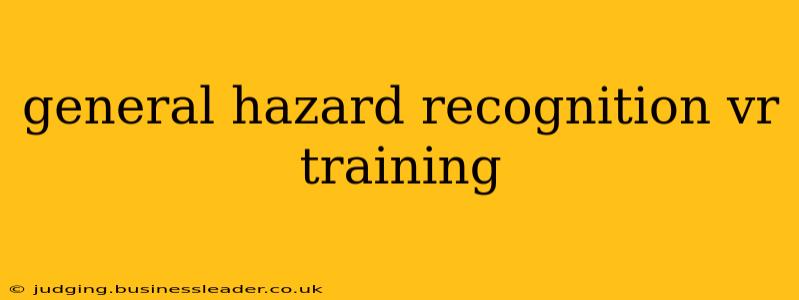The world of workplace safety is rapidly evolving, and Virtual Reality (VR) training is leading the charge. Gone are the days of relying solely on static posters and outdated manuals. General hazard recognition VR training offers an immersive, engaging, and effective method for teaching employees to identify and mitigate risks in their work environments. This innovative approach not only improves knowledge retention but also fosters a stronger safety culture within organizations.
What is General Hazard Recognition VR Training?
General hazard recognition VR training utilizes virtual environments to simulate real-world workplace scenarios. Trainees experience realistic situations, encountering various hazards they might face on the job. Through interactive exercises and challenges, they learn to identify potential dangers, understand the associated risks, and practice safe working procedures. This immersive experience allows for hands-on learning without the inherent risks associated with real-world training.
Why Choose VR for Hazard Recognition Training?
Compared to traditional training methods, VR offers several compelling advantages:
- Increased Engagement and Retention: VR's interactive nature keeps trainees actively involved, leading to significantly improved knowledge retention compared to passive learning methods like lectures or presentations.
- Safe Learning Environment: Trainees can practice identifying and responding to hazards in a risk-free virtual environment, preventing accidents and injuries that could occur during on-the-job training.
- Cost-Effective: While the initial investment in VR technology might seem significant, long-term cost savings can be realized through reduced accident rates, lower insurance premiums, and decreased training time.
- Improved Training Consistency: VR training delivers consistent, standardized training to all employees, regardless of location or scheduling constraints.
- Realistic Simulations: Advanced VR systems can create highly realistic simulations, replicating the nuances of various work environments and hazardous situations.
What Types of Hazards Can Be Included in VR Training?
The versatility of VR allows for the inclusion of a wide range of workplace hazards, including:
- Slips, Trips, and Falls: Trainees can navigate virtual environments filled with potential tripping hazards, learning to identify and avoid them.
- Electrical Hazards: VR can simulate the dangers of working with electricity, teaching safe practices for handling electrical equipment and avoiding electrical shocks.
- Fire Hazards: Trainees can experience virtual fire scenarios, learning to identify fire hazards, utilize fire extinguishers, and evacuate safely.
- Chemical Hazards: VR can showcase the dangers of handling hazardous chemicals, teaching safe handling procedures and the proper use of personal protective equipment (PPE).
- Ergonomic Hazards: Trainees can learn to identify and avoid ergonomic hazards that can lead to musculoskeletal injuries.
- Machine Hazards: Simulations can demonstrate the dangers of operating heavy machinery, emphasizing the importance of following safety protocols.
How Effective is VR Training Compared to Traditional Methods?
Studies have shown that VR training leads to significantly higher knowledge retention and skill acquisition compared to traditional methods. The immersive nature of VR enhances engagement and allows trainees to actively participate in the learning process, resulting in a more profound understanding of safety procedures.
What are the Benefits of General Hazard Recognition VR Training?
The benefits extend beyond improved safety performance. VR training contributes to:
- Reduced Workplace Accidents: By enhancing hazard recognition skills, VR training directly contributes to a reduction in workplace accidents and injuries.
- Improved Employee Morale: Engaging training experiences can boost employee morale and foster a positive safety culture.
- Enhanced Compliance: VR training ensures consistent adherence to safety regulations and best practices.
- Increased Productivity: A safer workplace translates to increased productivity and reduced downtime.
What are the Costs Associated with VR Hazard Recognition Training?
The costs associated with VR training vary depending on factors such as the complexity of the simulation, the hardware required, and the number of trainees. However, the long-term cost savings associated with reduced accident rates and improved safety performance often outweigh the initial investment.
How Can I Implement VR Hazard Recognition Training in My Workplace?
Implementing VR training involves selecting a suitable VR system, developing customized training content, and providing employees with the necessary training and support. Consult with VR training providers to determine the best approach for your specific needs and budget.
This new technology is transforming the way we approach workplace safety. By embracing general hazard recognition VR training, organizations can create safer, more productive, and more engaged work environments. The future of safety training is here, and it’s virtual.
